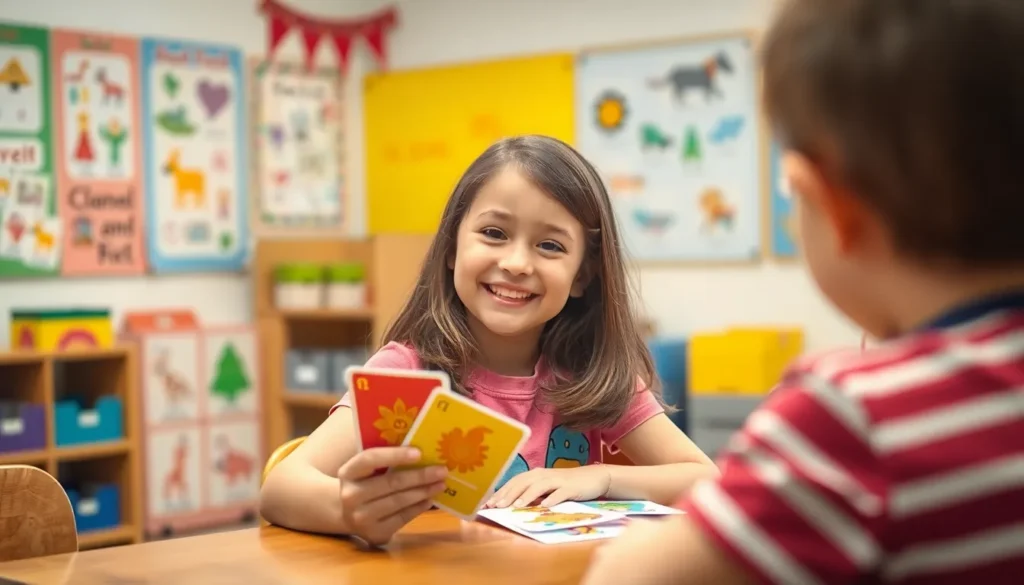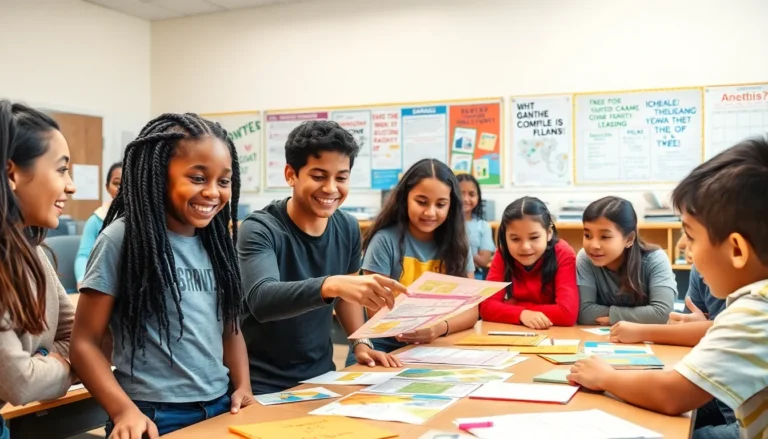Every parent and teacher knows the struggle: watching a child stare blankly at a page, wrestling with the same few words over and over. Sight word practice can feel like trying to teach a cat to fetch—frustrating yet oddly rewarding. But fear not! Mastering those pesky sight words is a game-changer in a child’s reading journey.
Overview of Sight Word Practice
Sight word practice involves repetitive exposure to common words, enabling children to recognize them quickly. Mastering these words boosts overall reading fluency and comprehension. Teachers often emphasize frequent review in engaging scenarios to maintain children’s interest.
Various techniques exist for sight word practice. Flashcards offer a portable and interactive way to reinforce learning. Games, such as bingo or memory, can enhance engagement while working on recognition. Incorporating digital tools also provides opportunities for fun and innovative learning methods.
Parents play a pivotal role in supporting sight word practice at home. Active participation encourages children to embrace learning experiences positively. Setting a routine, such as daily practice sessions, fosters consistency and strengthens word retention.
Progress monitoring remains crucial throughout the practice. Tracking improvements helps identify which words require additional focus. Regular assessments can be informal, such as quizzing during reading time.
Effective sight word practice contributes significantly to a child’s reading journey. Developing a sight word vocabulary correlates directly with enhanced reading skills. Encouraging children through varied and enjoyable methods can lead to long-term success.
Importance of Sight Words
Mastering sight words significantly impacts children’s reading abilities. These high-frequency words account for approximately 50-75% of the text in early reading materials.
Enhancing Reading Fluency
Sight words promote smoother reading experiences. Recognizing these words instantly eliminates the need for decoding, allowing focus on comprehension. As children read more fluently, they become confident, engaged readers. Repeated exposure to sight words fosters familiarity, meaning practice routines enhance fluency over time. Engaging activities like reading stories with sight words enhance retention while making practice enjoyable.
Building Vocabulary
Sight word practice also expands vocabulary size. Children encounter words frequently used in various texts, which supports understanding in different contexts. When they learn sight words in connection with new vocabulary, it reinforces language skills. Moreover, playful activities can introduce unfamiliar terms alongside sight words, broadening overall language exposure. Over time, a robust sight word vocabulary facilitates access to more complex texts, paving the way for richer reading experiences.
Effective Sight Word Practice Strategies
Sight word practice can be engaging and productive. Various strategies exist to enhance children’s recognition of sight words.
Flashcards and Visual Aids
Flashcards serve as a popular tool for sight word practice. Each card presents a single sight word, allowing for repetitive exposure. Visual aids strengthen memory retention, helping children associate words with images. Parents and teachers can create their own flashcards or use pre-made ones available online. Colorful designs capture attention, making sessions more enjoyable. Displaying flashcards in common areas encourages spontaneous review throughout the day. Transitioning from recognition to reading within sentences solidifies understanding and boosts fluency.
Interactive Games and Activities
Interactive games foster a fun environment for practicing sight words. Games like bingo capture children’s interest while reinforcing word recognition. Memory matching games challenge participants to pair words, enhancing retention through play. Virtual platforms offer engaging apps and online resources that motivate children to learn. Group activities promote collaboration and can lead to positive peer interactions. Introducing sight words into everyday conversations makes learning more natural and contextual. Activities that blend movement, like scavenger hunts, keep children active while they practice essential skills.
Sight Word Practice for Different Age Groups
Engaging sight word practice varies across age groups, addressing developmental needs effectively.
Preschool and Kindergarten
Practicing sight words at this stage focuses on recognition and understanding. Flashcards with colorful images attract attention while reinforcing word recall. Interactive activities like singing rhymes or matching games promote enjoyment and retention. Teachers often use props and visual aids to make learning memorable. Reading familiar books helps reinforce these words in context. Parents can incorporate sight words into daily routines, such as labeling objects around the house. Children benefit from short practice sessions, maintaining their interest and enthusiasm. Repetition strengthens memory, creating a solid foundation for future reading skills.
Elementary School
Sight word practice in elementary school shifts towards fluency and application. Daily reading becomes essential, allowing children to encounter sight words in various texts. Teachers encourage writing exercises that incorporate these words, fostering deeper connections. Utilizing apps and digital tools can enhance engagement and provide immediate feedback. Group activities like word scavenger hunts motivate collaborative learning. Progress tracking remains crucial, helping identify lingering challenges. Children should practice using sight words in sentences to improve comprehension. Games that involve competition or creativity can further elevate interest and participation. Each method contributes to building confidence in reading and understanding.
Challenges in Sight Word Practice
Sight word practice presents several challenges for both parents and teachers. Identifying and addressing these hurdles is vital for effective learning.
Common Mistakes to Avoid
Many overlook the importance of consistency in practice. Inconsistent reinforcement can lead to confusion and slow progress. Ignoring the child’s interests also proves detrimental, as engaging materials capture attention better. Meanwhile, excessive pressure may cause frustration, hampering motivation. Another mistake involves underestimating the value of diverse activities. Implementing varied techniques, such as games and stories, enhances retention. Prioritizing these strategies helps solidify word recognition and understanding.
Addressing Learning Differences
Recognizing learning differences is essential for effective sight word practice. Some children may struggle with specific skills, such as decoding or memorization. Tailoring approaches to individual needs supports diverse learners. Utilizing multisensory techniques, like visual aids or tactile experiences, engages various learning styles. Frequent reassessment monitors progress and informs necessary adjustments. Encouragement also plays a crucial role, as positive reinforcement fosters confidence. By addressing these differences, practitioners can promote a more effective learning environment.
Conclusion
Sight word practice is essential for a child’s reading development and overall language skills. By utilizing engaging techniques and maintaining a consistent routine, parents and teachers can create a supportive environment that fosters learning. The journey may present challenges, but with patience and creativity, children can achieve mastery and build confidence in their reading abilities. Emphasizing enjoyment and interaction will not only enhance retention but also encourage a lifelong love for reading. As children expand their sight word vocabulary, they unlock access to more complex texts, enriching their educational experiences. Investing time in effective sight word practice pays off in the long run, laying the foundation for successful reading journeys ahead.







